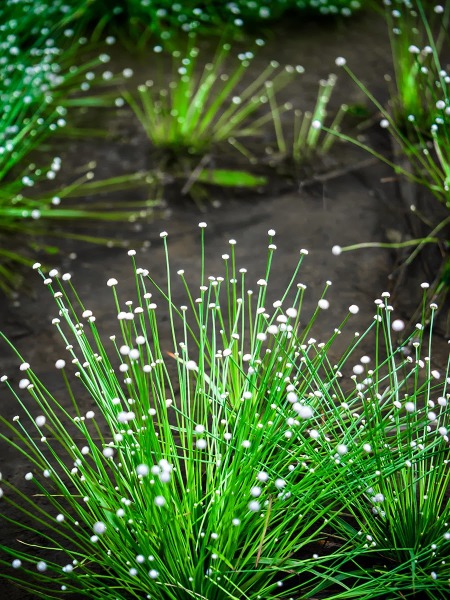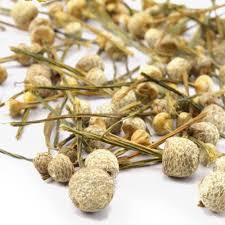[1] Barefoot Doctor's Manual- 1977 Prepared
by the Revolutionary Health Committee of Hunan Province. Original Chinese manual-
Victor W. Sidel. Originally published by Dr Joseph Quin and the Fogarty International
centre, Bethdesda (1974). Madrona Publishers Seattle Washington ISBN 0-914842-52-8
[2] A Complete English Dictionary of Medicinal Terms in Chinese Acupuncture
and Herbalism 1981- Henry Lu Chinese Foundations of Natural Health- The Academy
of Oriental Heritage, Vancouver, Canada.
[3] Translation notes from Gary Seiford and Hocu Huhn- NSW College of Natural
Therapies. Sydney Australia (1982).
[4] Chinese Herbal Medicine Materia Medica- Dan Bensky and Andrew Gamble- Eastland
Press 1986 Seattle Washington ISBN 0-939616-15-7
Images
1.
towerecord.blogspot.com.au
2.
[1]
3.
old.tcmwiki.com
4.
okk123.com
Chemical analysis of Eriocaulon buergerianum and adulterating species
by high-performance liquid chromatography with diode array detection and electrospray
ionization tandem mass spectrometry.
Qiao X, Ye G, Liu CF, Zhang ZX, Tu Q, Dong J, Li YQ, Guo DA, Ye M.
Abstract
Eriocaulon buergerianum Koern. is the botanical source for the Chinese herbal
medicine Gu-Jing-Cao. Other Eriocaulon species are also used as the same herb
in local areas and are difficult to be differentiated. In order to improve the
quality control of Gu-Jing-Cao, chemical constituents of E. buergerianum and adulterating
species were analyzed by high-performance liquid chromatography with diode array
detection and electrospray ionization tandem mass spectrometry (HPLC-DAD-ESI-MS(n)).
The 70% methanol extracts were separated on a Zorbax SB-C(18) column and eluted
with acetonitrile-water (each containing 0.1% formic acid). The compounds were
identified by ion-trap mass spectrometry in both positive and negative ion modes.
From E. buergerianum, E. faberi, E. sexangulare and E. cinereum, a total of 72
compounds were characterized, including 37 flavonols, 6 flavones, 4 isoflavones,
6 xanthones, 14 naphthopyranones, 3 phenolic acids, and 2 other flavonoids. Chemical
variation of these four species were studied at three tiers, HPLC fingerprinting,
quantitation of six major flavonoids, and semi-quantitative analysis of all characterized
compounds, in combination with principal component analysis. E. buergerianum contained
abundant flavonols and naphthopyranones, with minor flavones and xanthones; E.
cinereum contained abundant isoflavones and flavones, together with few naphthopyranones;
E. sexangulare was rich in flavones; and E. faberi contained abundant xanthones.
Based on the above chemical analysis, E. buergerianum could be explicitly differentiated
from the adulterating species, and the botanical species of 13 commercial batches
of Gu-Jing-Cao were identified correctly. This is the first report on comprehensive
chemical analysis of Eriocaulon species.
PMID: 21920689 DOI: 10.1016/j.jpba.2011.08.033 J Pharm Biomed Anal. 2012 Jan
5;57:133-42. doi: 10.1016/j.jpba.2011.08.033. Epub 2011 Aug 27.
ncbi.nlm.nih.gov
Morphological and chemical analyses of Eriocauli Flos sold in Taiwan
markets.
Lee IJ, Chung CP, Chang SJ, Lin YL.
Abstract
Eriocauli Flos (Gujingcao; EF), the dried capitulum with the peduncle of Eriocaulon
buergerianum Koern. (Eriocaulaceae), is a Chinese herbal medicine for treating
eye diseases and inflammation. However, several species of the Eriocaulon genus
are used as substitutes in different areas. To examine the species of EF used
in Taiwan and to establish the quality control platform, morphological and chemical
analyses have been performed. Ten major compounds, including apigenin (7) and
its 7-O-β-D-glucopyranoside (1) and 7-O-(6-O-E-coumaroyl)-β-D-glucopyranoside
(6), hispidulin (8) and its 7-O-β-D-glucopyranoside (2) and 7-O-(6-O-E-coumaroyl)-β-D-glucopyranoside
(5), jaceosidin (9) and its 7-O-β-D-glucopyranoside (3), and toralactone (10)
and its 9-O-β-D-glucopyranosyl(1→6)-β-D-glucopyranoside (4), were isolated and
identified from commercially available EF. Morphological investigation showed
that two kinds of EFs and most of the EFs sold in Taiwan herbal markets are
capitulum without the peduncle. A simultaneous high performance liquid chromatography
and ultra performance liquid chromatography analyses of multiple components
(1-10) in commercially available EFs, collected from different areas of Taiwan,
was conducted. Results showed wide variations in morphology and chemical profiles
between capitulum with and without the peduncle. In comparison with an authentic
E. buergerianum, we found not only the morphology but also the chemical profile
was different from both collected samples. In terms of the morphological examination,
the samples without peduncle are closer to the authentic one. To ensure the
correct EF materia medica is used in Taiwan so as to guarantee their therapeutic
efficacy in clinical practice, further monitoring is necessary.
PMID: 28987371 DOI: 10.1016/j.jfda.2017.01.002 J Food Drug Anal. 2017 Oct;25(4):939-945.
doi: 10.1016/j.jfda.2017.01.002. Epub 2017 Feb 16.
ncbi.nlm.nih.gov
Bioactive compounds of Eriocaulon sieboldianum blocking proliferation
and inducing apoptosis of HepG2 cells might be involved in Aurora kinase inhibition
Yanhua Fan, Hongyuan Lu, Hongda Ma, Fan Feng, Xiaolong Hu, Qiao Zhang, Jian
Wang, Yongnan Xu* and Qingchun Zhao*
Abstract
Eriocaulon sieboldianum (Sieb. & Zucc. ex Steud.) is an edible and medicinal
plant used in traditional Chinese medicine. Often in combination with other
herbs, it is processed into healthcare beverages for expelling wind-heat, protecting
eyes, and reducing blood lipids. Besides, its water decoction together with
other herbs has been utilized to treat cancer in China. However, the active
ingredients and the precise cellular mechanisms of E. sieboldianum remain to
be elucidated. The Aurora kinase family plays critical roles in the regulation
of cell division and has attracted great attention to the identification of
small-molecule Aurora kinase inhibitors for potential treatment of cancer. A
molecular docking study was employed for docking of the most bioactive compounds.
Hispidulin (HPDL) and quercetin-3-O-(6′′-O-galloyl)-β-D-galactopyranoside (QGGP)
were singled out as potent inhibitors of Aurora kinase. Their inhibitory activity
towards Aurora kinase was further confirmed by the obvious decrease in autophosphorylation
of Aurora-A (Thr288) and Aurora-B (Thr232). Moreover, the induction of cell
cycle arrest in HepG2 cells and the suppressed phosphorylation of histone H3
were also consistent with the inhibition of Aurora kinase. The data indicate
that the E. sieboldianum extract and its two active compounds, HPDL and QGGP,
could effectively induce apoptosis via p53, MAPKs and the mitochondrial apoptotic
pathways. These findings could improve the understanding and enhance the development
of drugs based on E. sieboldianum and raise its application value in anticancer
therapy or prevention. In addition, our results indicated that Aurora kinase
might be a novel target of HPDL and QGGP.
Issue 12, 2015 Food & Function
pubs.rsc.org
 HABITAT:
HABITAT:  Eriocaulon
buergerianum. E. sieboldianum 谷
经 草 Gǔ
jīng cǎo-"Grain
essence herb"
Eriocaulon flower,
Pipewort Family: Eriocaulaceae
Eriocaulon
buergerianum. E. sieboldianum 谷
经 草 Gǔ
jīng cǎo-"Grain
essence herb"
Eriocaulon flower,
Pipewort Family: Eriocaulaceae


 HABITAT: Found growing
in damp shady places.
HABITAT: Found growing
in damp shady places.